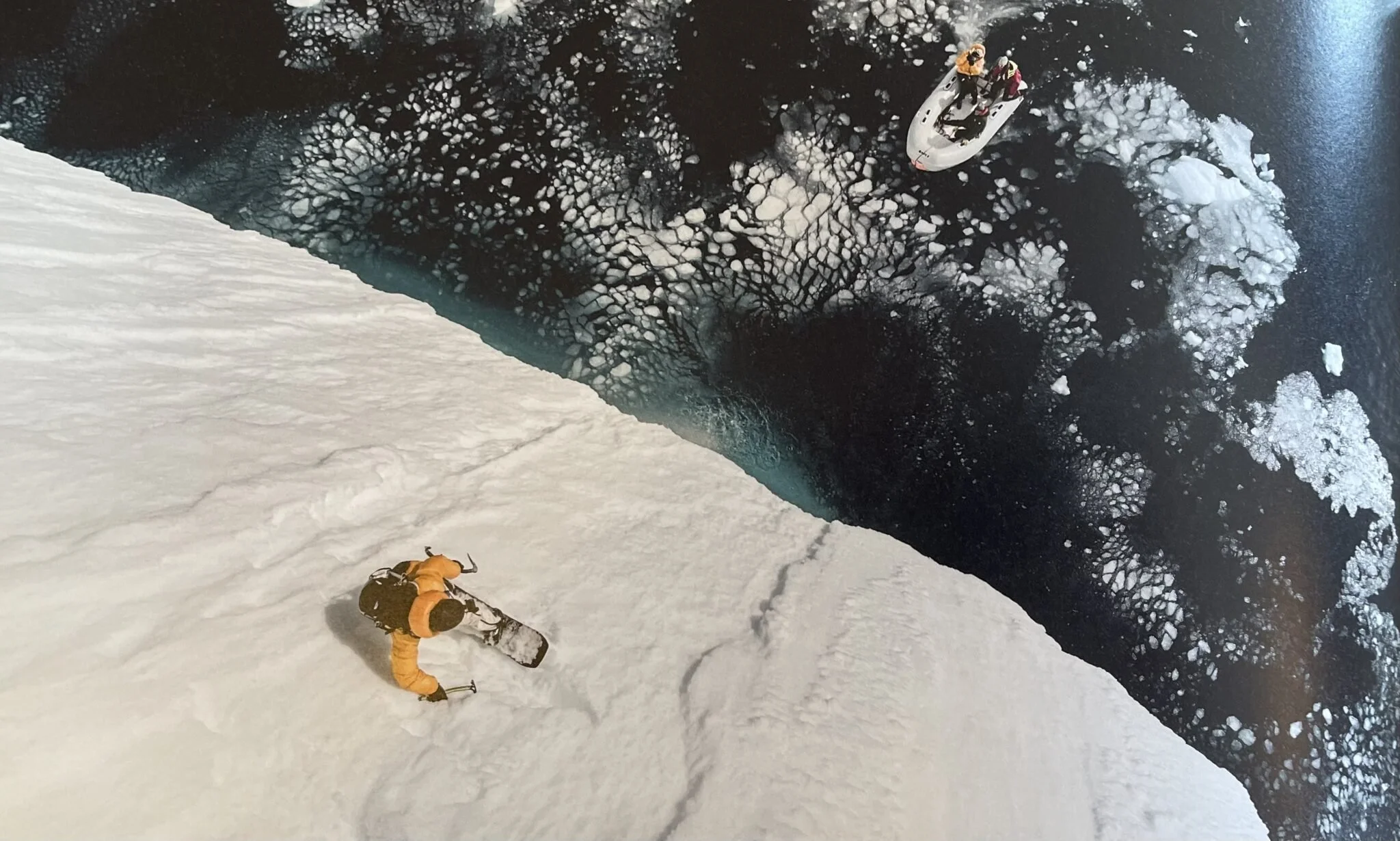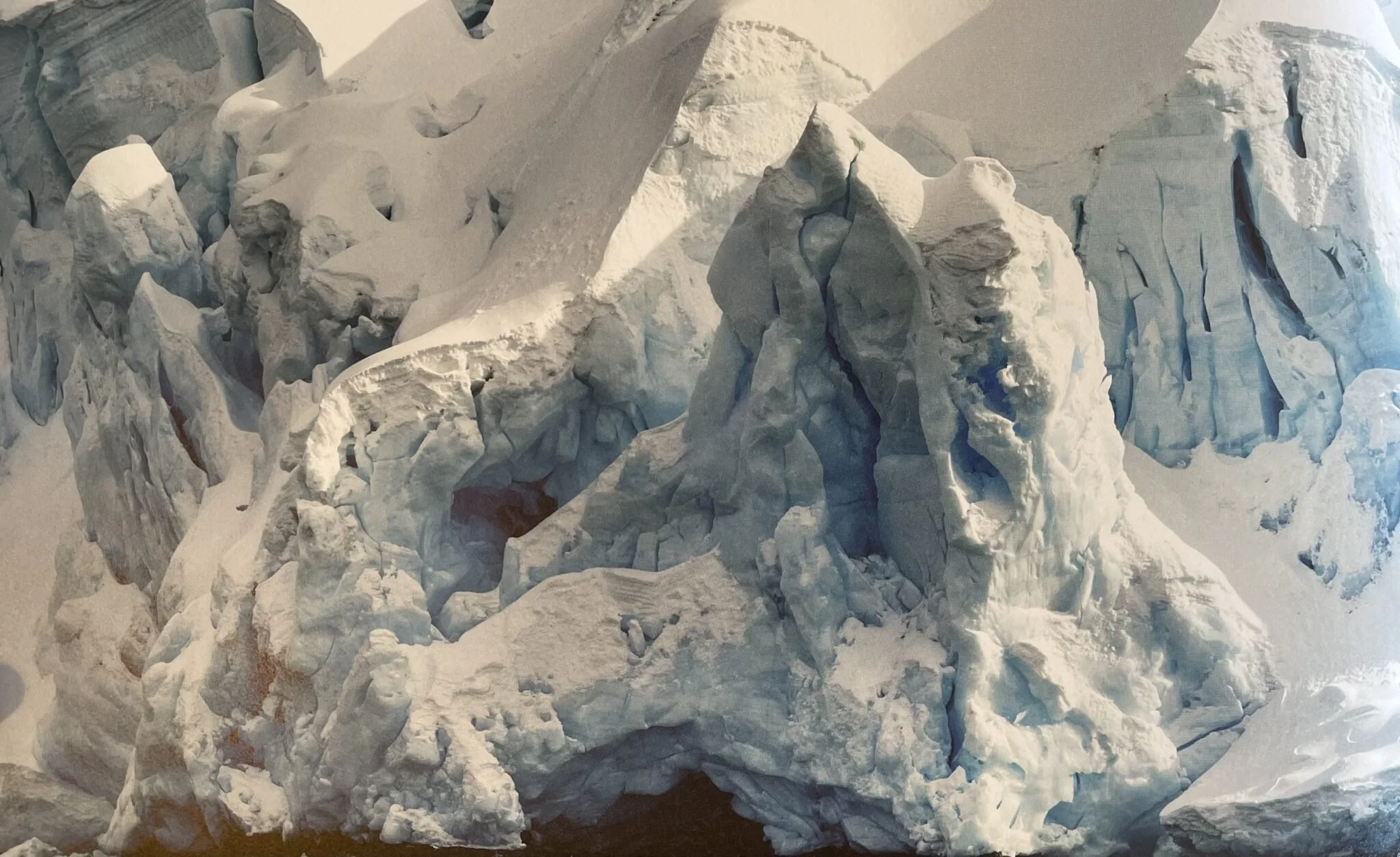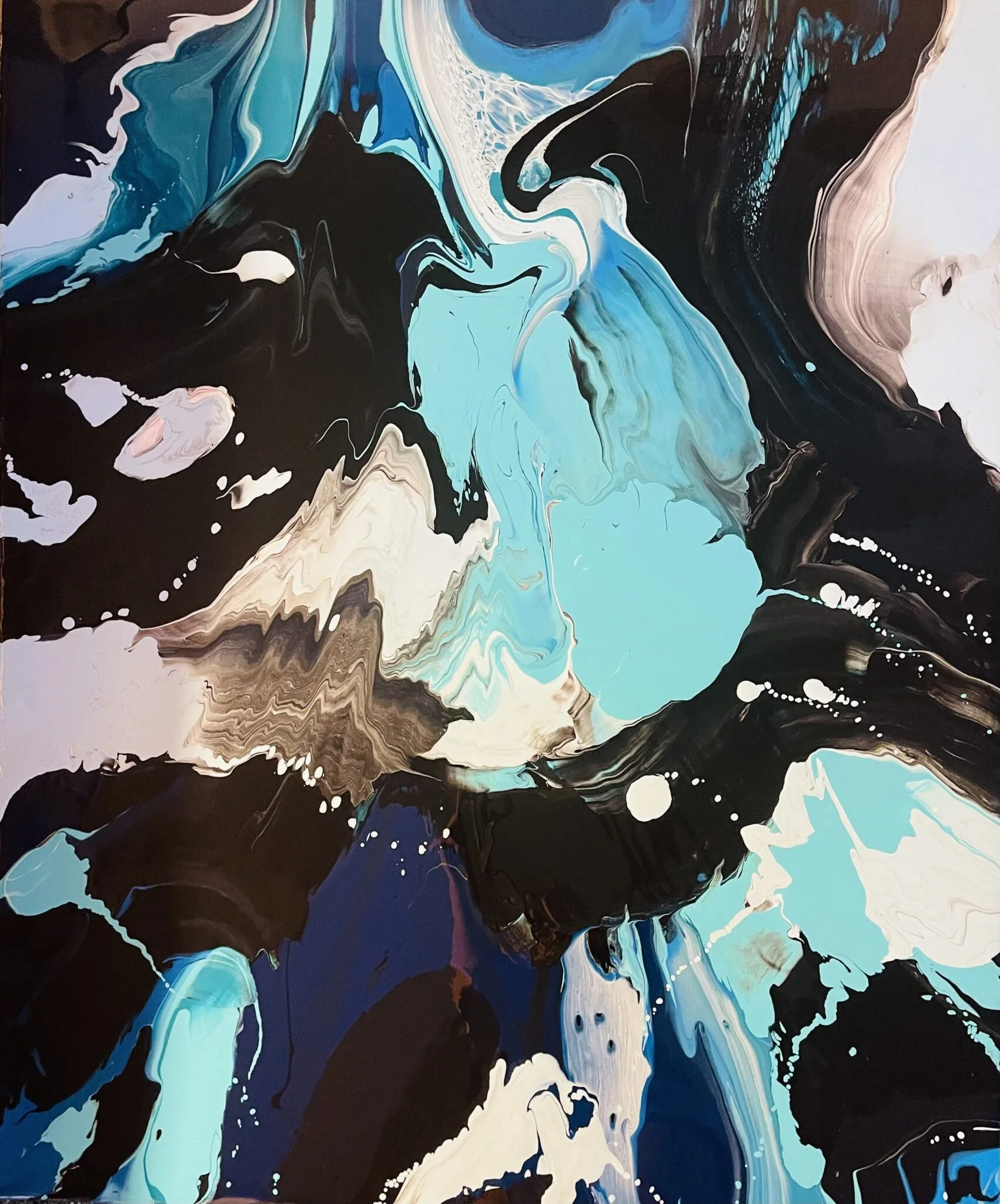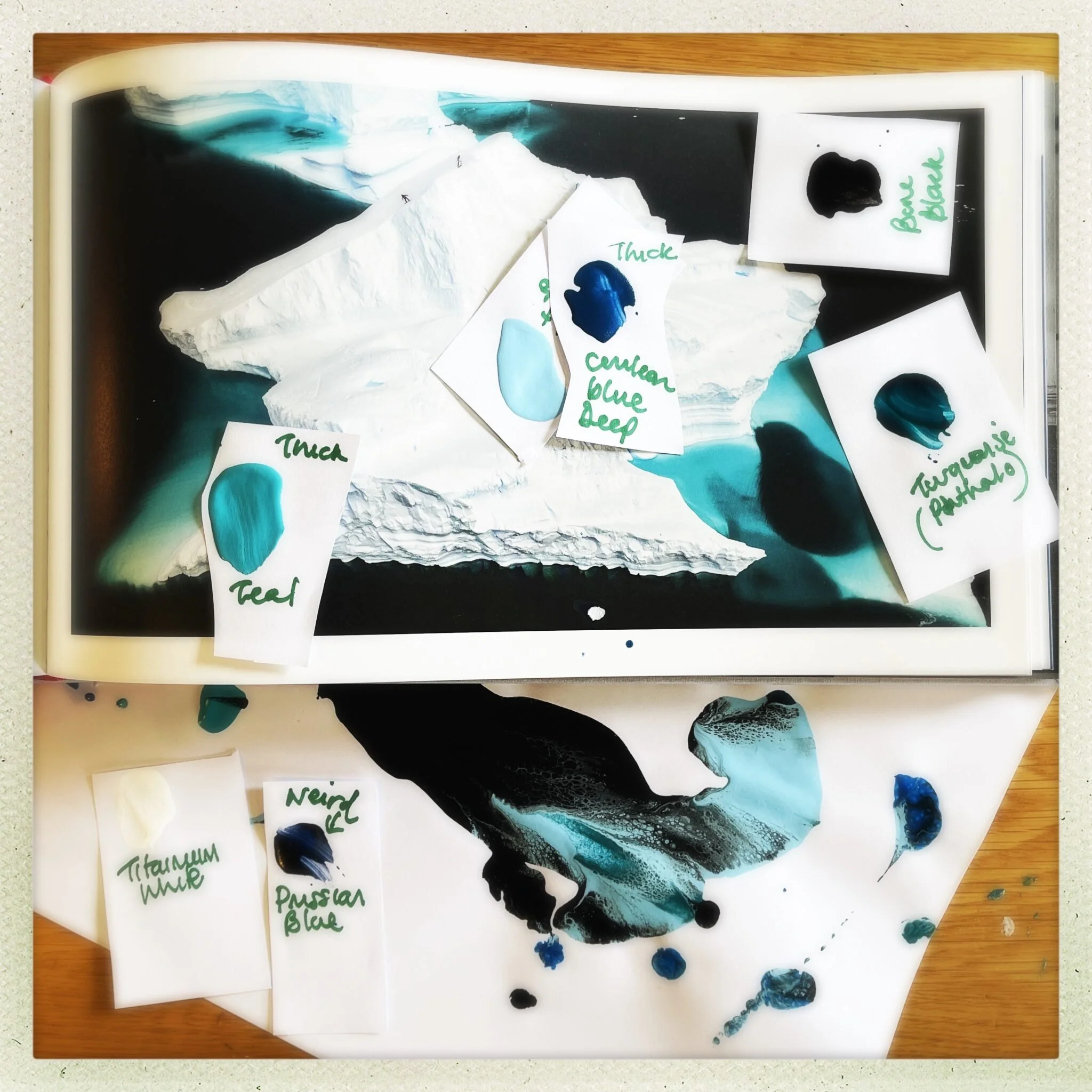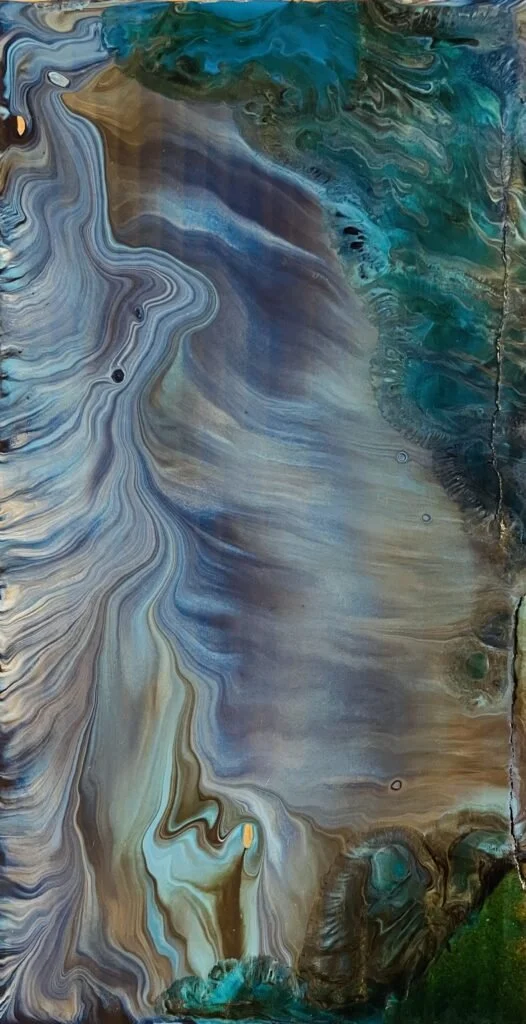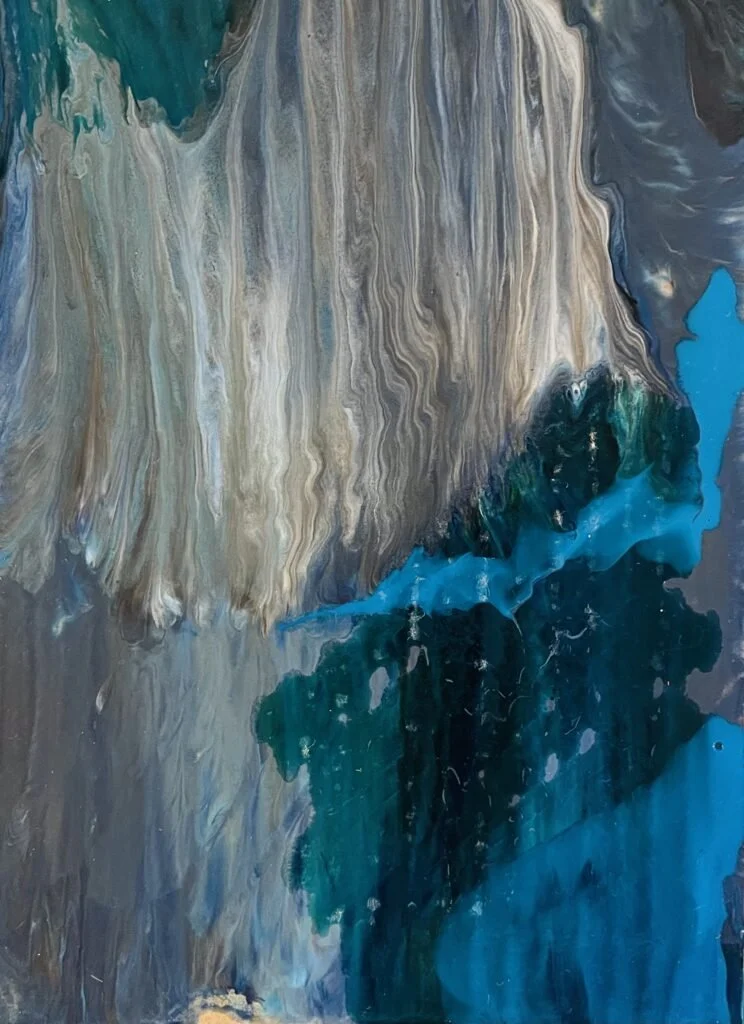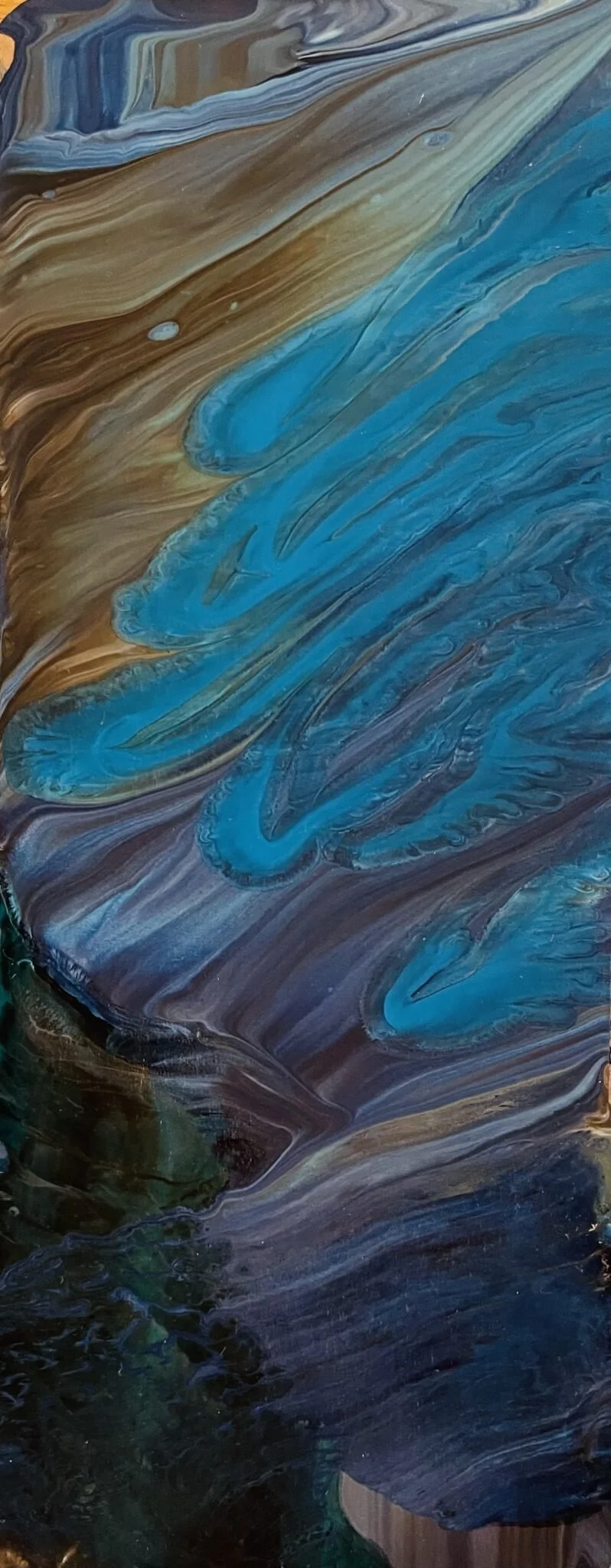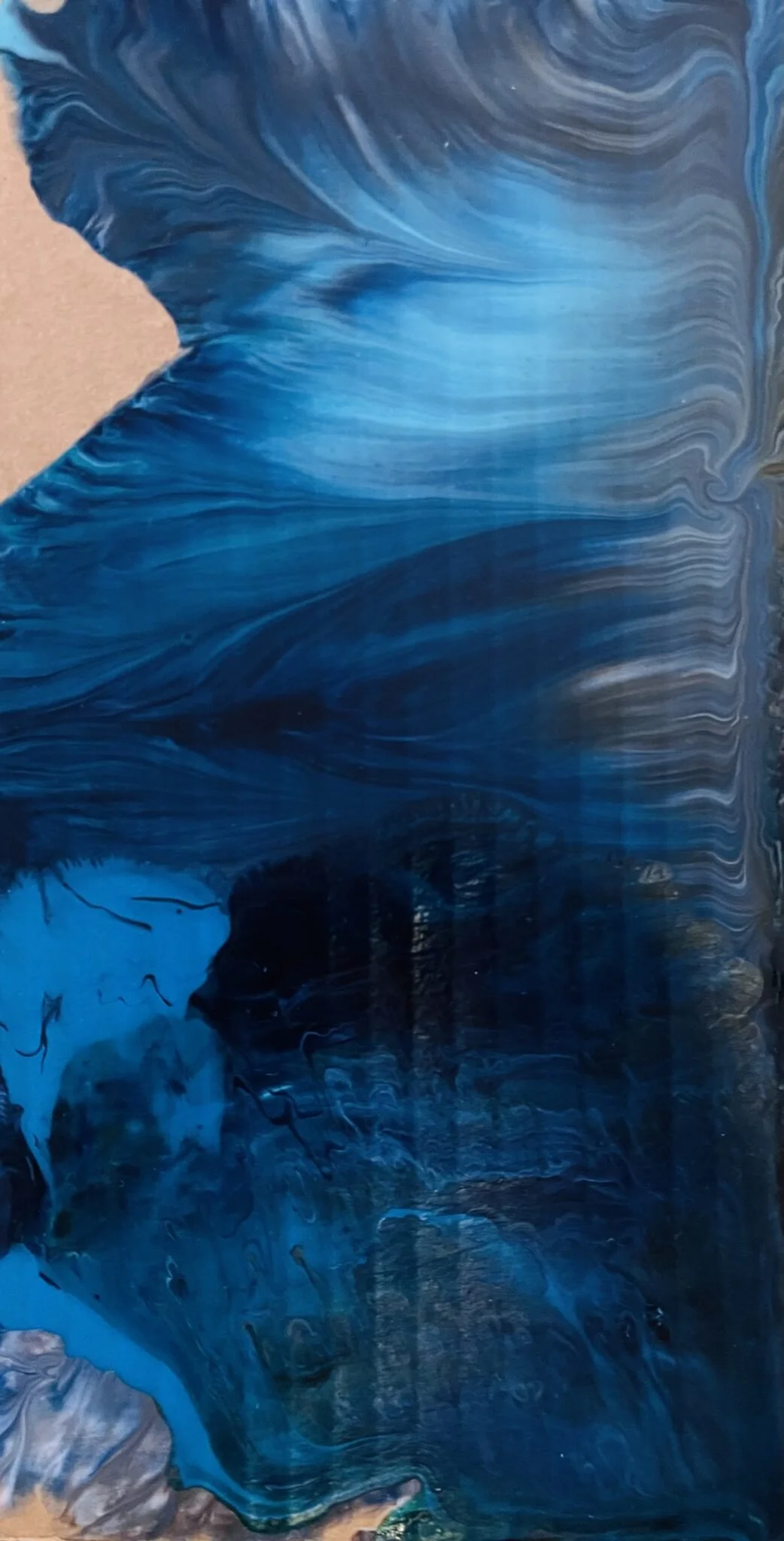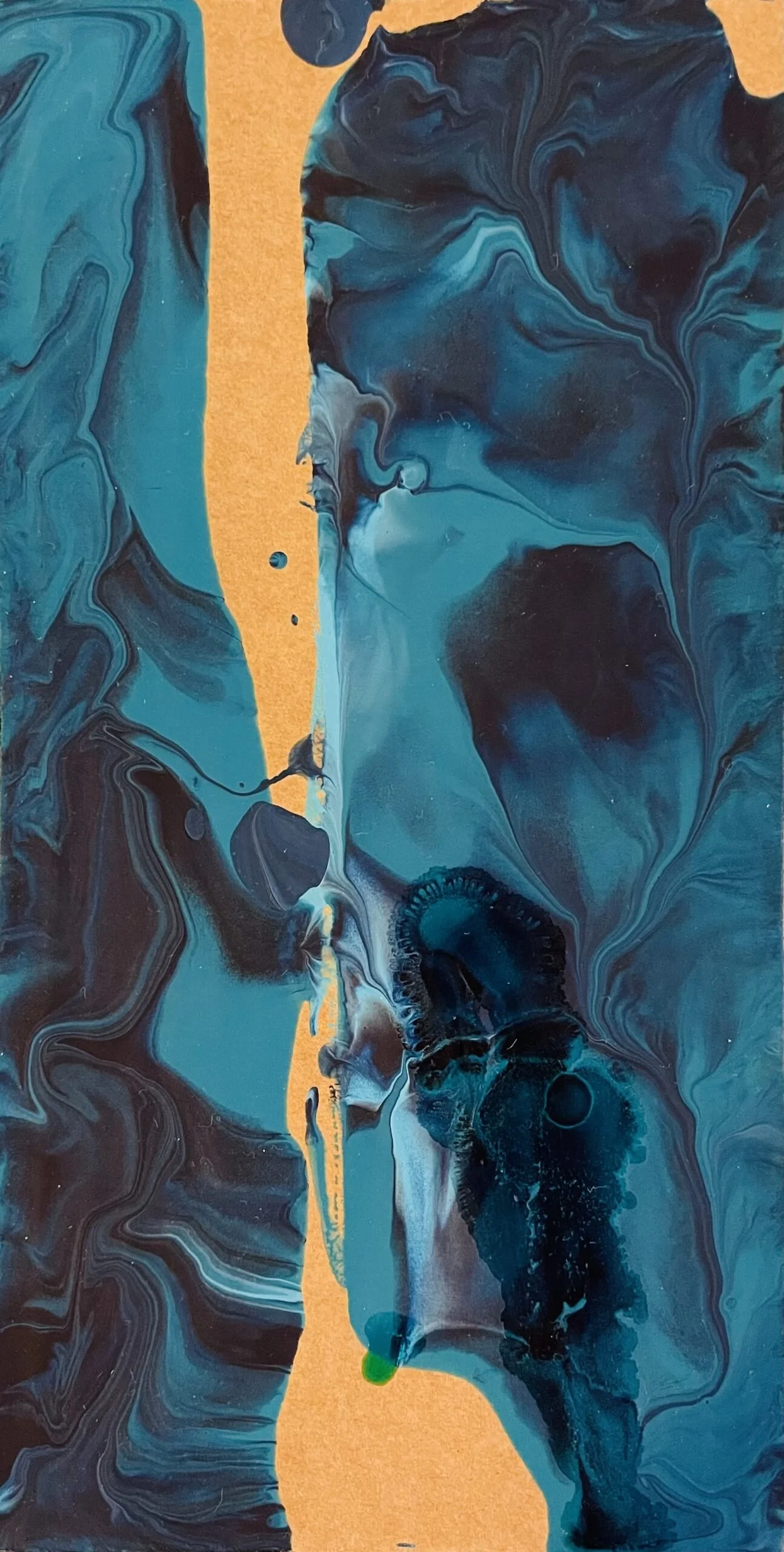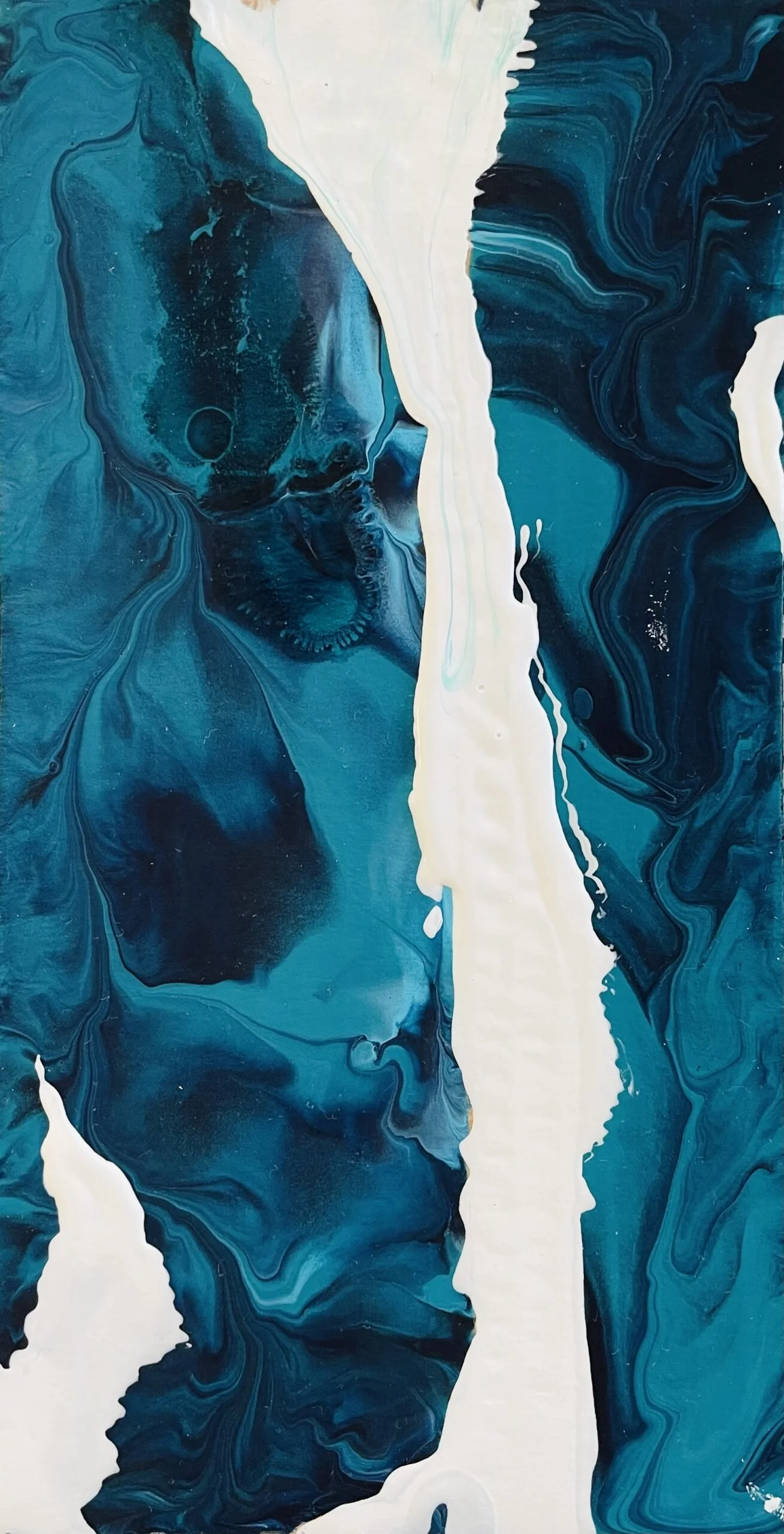Flockhart K, Fluid Paint Study (2025)
Create a personal project in the studio developing your work. Use your Personal Project Proposal and tutor feedback to inform this body of work. This is your opportunity to make a drawing, or series of drawings, you are really excited by.
“And then everything drops away. You release the ego and things start to happen. In a state of surrender I sit and all the phrases, influences, ideas, notes, guidelines, limitations, swirl in an endless loop. It’s not a fountain head moment, it’s a tornado.
Like oil rising to the surface, the strongest inspirations finally rise to be visible. They were once whispering quietly, amongst all the other contenders, but as time goes on the physical relationship with the work develops. I am working towards something unknown and anything not relevant is forced aside”. (Flockhart K, 2025)
PROCESS ANTARCTICA
Initially I was trying to express the whole adventure. I had begun with some early drawings experimenting with texture, volume, evident colours – natural and artificial.
My intention for the main piece was to invoke the atmosphere. The dark mass of water, its glassy stillness that exposes your vulnerability. The broken pieces of ice. Teal and turquoise sectors around the icebergs, beautiful and alluring, a respite from that sinister black mass.
And then the elements, rising out of the water. On land turning into twisting masses of rock, ice and snow. And in water, floating apparitions.
But as I worked unexpected things happened. The paint moved and manipulated itself into new positions. Brought on by the weight of the medium on the flexible canvas stretcher. It ran away off the side and then dipped into a large puddle in the middle. I tried to think on my feet, I had to work wet in wet, and I referred to the photographic images for reference. But soon the whole book was pouring out of my brain and the work came polluted and congested. I found myself capsized, a very long way from my original idea.
Fig.5 Flockhart K, Untitled Paint Pour (2025)
Fig.6 Flockhart K, Resource Study: Of A Lifetime (2025)
I navigated back to the beginning of the project P5, where my first thoughts and sketches were preserved.
I have struggled with the duality of representation and interpretation. Not really knowing whether I should separate the 2, or if there’s a negotiation in practice, that uses both elements. This project really took me into the depths of exploring that relationship.
Some of the conflict was in how the finished work was going to be approached, by myself and the viewer. Ultimately I had to let go of a sense of duty and expectation. And allow the subject to pass through me. I related to the quote in Fortnum’s essay, from Mieke Bay, Looking In: The Art Of Viewing.
“Perception, however, is a psychosomatic process, strongly dependant, for example, on the position of the perceiving body in relation to the perceived object…….The degree of familiarity with what one sees also influences one’s perception…….Perception, in fact, depends on so many factors that it is pointless to strive for objectivity”.
Initially it seemed perverse to disturb my intention and commitment to representation. But switching gears can often mobilise the work and drive it’s trajectory forward.
I looked at the work sequentially. I thought about what adjectives and verbs represented my subjects. I looked at the mass of studies and experiments that had scattered around my larger painting. There was a connection between certain imagery and narration, that began to form a ‘life raft’ (Fortnum).
The large scale piece I had created (Fig.5), had many attractive and interesting elements. And Im sure I could have passed this off. But it felt like an easy way out. This was not my intention, I wanted to go beyond work I knew I could produce. I wanted to pass that plateau.
That was the whole point of choosing this narrative, because it’s a story of challenge and over coming.
The smaller studies (Fig.7-12) had those qualities. Unexpected divisions of applications, creating dialogue within the painting (albeit the colours are ‘off’).
And in Fig.11-12, filling in the dividing space with a fresh narrative element. The ice white landscape. This had more impact, and my instinct was pulling in this direction. I believed at that point, that if I could produce this on a larger canvas, I could then add informing elements or details that would bring the painting to fruition.
CONCLUSION
This work, (and I feel all my work) is not about repeating an experience. It’s about that experience moving through me, and being interpreted in an authentic language. To engage with resources, negotiate between intention and realisation.
I will not create an expected scene. A painterly interpretation of the images in the book. An obvious narrative to the descriptive text. Painting challenges me, in the way the expedition challenged my friends. With all their intent and expectation they navigated abstract influences. Relationships, emotions, elements, time, energy. Was every excursion exactly as they planned? Were there unexpected opportunities leading to moments of exhilaration? Were internal storms necessary to break away tensions to lead to peace and triumph?
Evolution and achievement eventually finds it’s way. Through the ability to let go and let the experience shape itself within it’s own theatre.
Look for ways that enable you to explore subjectivity and agency on your own terms.
Echoing the intrinsic nature of a place
The location
The physical journey
The dialogue
Some friends went to Antartica. They wrote a book and made a film.
I read the book and watched the film.
I saw dense masses of water.
Imposing icebergs.
Flecks of water from rough seas.
I saw man made colours highlighting the raw elements,
bright red sailing ropes, violet jackets.
Black and white penguins and Orcas.
I felt their eyes widen and their stomachs shrink.
I witnessed the abyss of the seas, the floating shapes, and the triggers of inspiration.
And this is what I made. (Flockhart K, P5 Self & Others)
List of Images
Cover Image Flockhart, K. (2025) Fluid Paint Study. [Pouring paint and acrylic on cardboard] In possession of: The author: Volleges.
Fig.1 – Fig.4 Tanon, J. Thoresen, C. Perrini, G. Gallyon, S. (2024) Of A Lifetime. [Photography] Published by: Club Sandwich Studio.
Fig.5 Flockhart, K. (2025) Untitled Paint Pour. [Pouring paint and acrylic on canvas] In possession of: The author: Volleges.
Fig.6 Flockhart, K. (2025) Resource Study: Of A Lifetime . [Photo and pouring paint on paper] In possession of: The author: Volleges.
Fig.7 Flockhart, K. (2025) Fluid Paint Study. [Pouring paint and acrylic on cardboard] In possession of: The author: Volleges.
Fig.8 Flockhart, K. (2025) Fluid Paint Study. [Pouring paint and acrylic on cardboard] In possession of: The author: Volleges.
Fig.9 Flockhart, K. (2025) Fluid Paint Study. [Pouring paint and acrylic on cardboard] In possession of: The author: Volleges.
Fig.10 Flockhart, K. (2025) Fluid Paint Study. [Pouring paint and acrylic on cardboard] In possession of: The author: Volleges.
Fig.11 Flockhart, K. (2025) Fluid Paint Study. [Pouring paint and acrylic on cardboard] In possession of: The author: Volleges.
Fig.12 Flockhart, K. (2025) Fluid Paint Study. [Pouring paint and acrylic on cardboard] In possession of: The author: Volleges.
Bibliography
Fortnum, R (2005) What is visual intelligence and how do artists use it?At:http://www.visualintelligences.com/visual-intelligence-how-artists-use-it.html (Accessed 05.08.2025).

